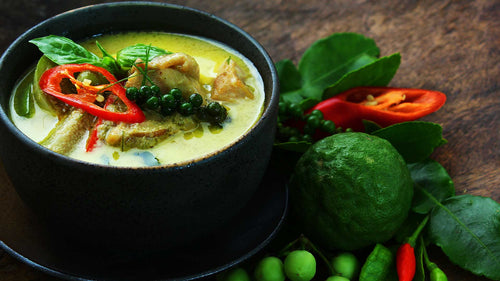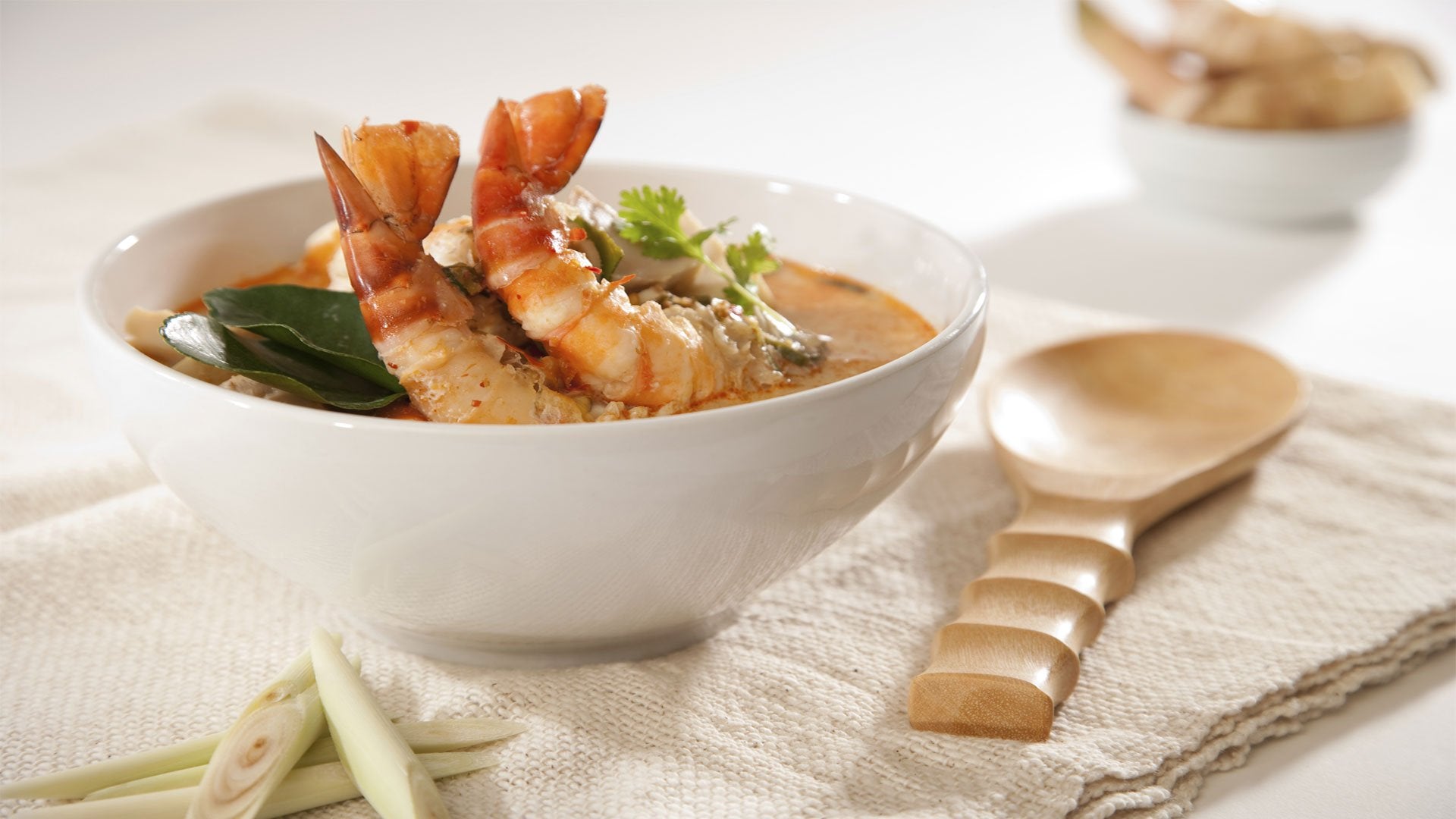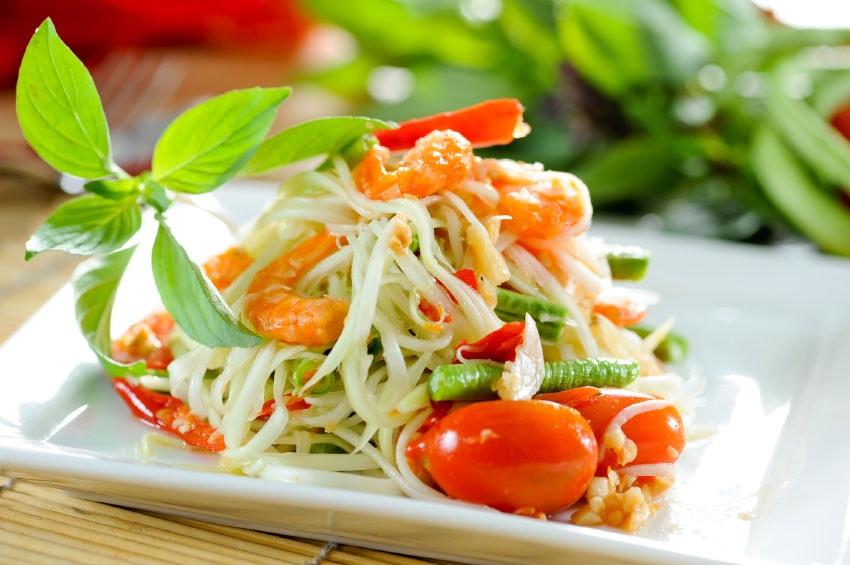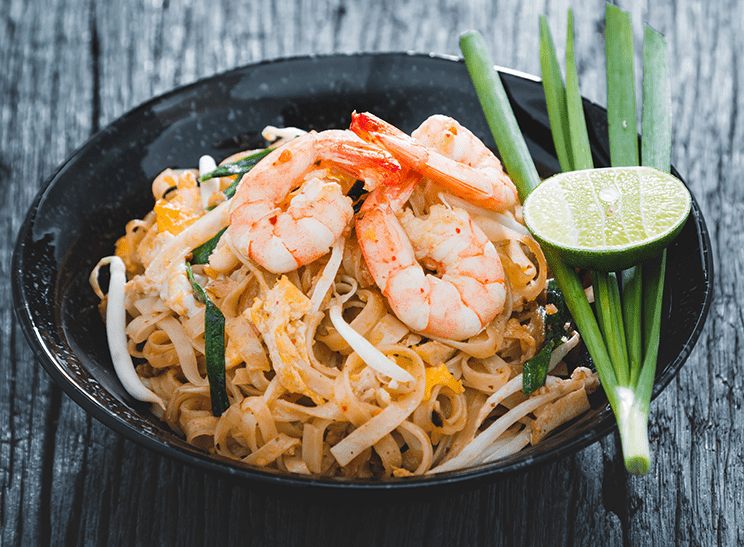Laksa is one of the most fragrant and flavour packed soup dishes in Southeast Asia. You could even go as far as to say one of the most fragrant and flavour packed dishes in general. This iconic soup which comes in two variations combines delicious southeast Asian herbs and spices, meat or plant-based protein, coconut milk (optionally depending on which variation you’re making) with rice noodles for the ultimate soothing soup broth topped with Laksa classics like bean sprouts, tofu puffs, chillies, spring onions and herbs. The most commonly used herbs for Laksa are either mint or Vietnamese coriander, which is used so much it’s sometimes nicknamed ‘laksa leaf’.
So, whether you’re already a Laksa fanatic or you’re interested in simmering this soup to perfection in your own kitchen; in this blog, we’re guiding you through everything you need to know about Laksa Soup; from a brief introduction to its origins, the different types of Laksa to how to prepare your own Laksa paste or save time with convenient ready made Laksa paste and meal kits. Keep reading to discover tips to help you make your best authentic Laksa soup recipe!
What is Laksa?
In simple terms, Laksa is a spicy noodle soup of Peranakan origin. Peranakan refers to the mixed heritage of Chinese, Indonesian and Malaysian culture within Southeast Asia. As such, authentic Laksa takes notes from the cuisine of each of these cultures; the rice noodles coming from China and the curry-like flavours coming from Southeast Asia. Laksa is also popularly eaten across other Asian countries in general but in particular Singapore and southern regions of Thailand.
What is the difference between curry laksa and assam laksa?
Within Southeast Asia, there is a wider variety of Laksa recipes with regional differences according to preference and local ingredient availability. For example within Malaysian Laksa, some variations such as Nonya or Kuah Putith both don’t use curry powder but one uses a shrimp based broth (Nonya) and the other uses a fish based broth (Kuah Putith).
However, generally Laksa can be separated into two main categories, curry laksa and assam laksa. Some people also like to define the two categories by the main ingredients, noodles or soup. So what’s the difference between curry laksa and assam laksa?
CURRY LAKSA
Of the two types, curry laksa is the most popular eaten type of Laksa. This type of Laksa is also referred to as ‘Curry Mee’ and uses coconut milk as a key ingredient in its recipe. Curry laksa has a rich and creamy texture but also the fiery kick of spice from the use of curry powder or paste (and also the sliced chillies used to garnish). Boiled eggs, tofu puffs, beansprouts and mint or coriander are the typical toppings found on Curry Mee, along with a serving of sambal chilli paste either also on top or on the side.
ASSAM LAKSA
Meanwhile Assam Laksa is a much lighter soup recipe which doesn’t use coconut milk to achieve a refreshing fish-based broth, the word ‘assam’ in Malay describes ingredients in food which create a sour taste. Assam Laksa lends its sour flavours from tamarind and ginger flower. Ginger flower isn’t a widely available ingredient outside of Southeast Asia. However, the deliciously sour tangy flavour of assam laksa can still be achieved without it by preparing a paste which combines shrimp paste, galangal, shallots, lemongrass, chillies and more to stir through the broth. While the consistency of Assam Laksa is lighter with shredded fish pieces such as mackerel, it’s still served with rice noodles and completed with sweet, fresh, zesty and complimentary toppings to the sour soup such as cucumber, mint, pineapples and limes.
What is laksa paste and what is it made from?
Laksa Paste is the foundation of all the flavours found in a good Laksa recipe and infuses iconic aromatic ingredients from Southeast Asia like galangal, lemongrass, kaffir lime leaves. The ingredients of a Laksa paste may vary depending on the type of Laksa and personal preference for ingredients and quantities but one thing that should always be present in a Laksa paste (unless you’re preparing a vegan alternative) is the essential ingredient - shrimp paste!
Check out a quickie and easy two-step Laksa paste recipe below:
Laksa Paste Recipe
-
Place coriander, paprika, cumin and turmeric in a small frying pan over medium heat. Cook for 1 to 2 minutes or until fragrant. Allow to cool completely.
-
Next add the chillies, galangal, garlic, lemongrass, onion, shrimp paste and toasted spices into a food processor or blender until the pieces are fine in consistency. Then add oil and blend again until the mixture forms a smooth paste.
-
Store this paste in an airtight container and it will keep best in the fridge for up to 5 days.
Ready Made Laksa Pastes
When making a truly authentic Laksa recipe, fresh, homemade paste is the best option for the perfect Laksa, however in recent years, ready made Laksa pastes and meal kits have proven to deliver great results for a delicious and time efficient alternative. Below are some great options of ready made Laksa paste, sauce and meal kit products to cook a range of curry laksa recipes.
Ready made Laksa products:
A tried and tested authentic laksa paste with all natural ingredients to create the perfect curry laksa flavours. This paste features an easy prawn laksa noodles recipe on the packaging which serves 4 to 6. All you need is cooked prawns, coconut milk, bean sprouts, fresh coriander leaves and you’ll be devouring a delicious laksa in no time!
Make your laksa Singapore style with this Yeo’s Laksa paste which features a time-saving 20 minute recipe on the packaging! Singaporean laksa gets it’s fragrant spicy coconut broth flavours from ingredients like coconut extract, lemongrass, chilli powder, ginger and more. This paste is also suitable for vegans and vegetarians.
This paste is made to perfect the spicy noodle soup flavours of laksa soup with notes of coconut and citrus! What’s great about this paste is that it holds the wonderful authentic taste of a true laksa, while still being palatable for people with a lower spice tolerance with extra coconut milk.
Laksa soup can also be enjoyed as a light starter and this laksa kit from Malay Taste is perfect for preparing a laksa soup starter for two in just 15 minutes! Containing a smaller sachet of laksa paste to the jar, along with coconut milk and rice noodles; we highly recommend this for beginners.
Asian Home Gourmet’s Singapore’s laksa paste sachet is another great option for those who are looking to try laksa for the first time or who want a quick fix without having to commit to a whole jar. This paste features a 3 step recipe to prepare the delicious classic laksa coconut curry noodles for 3 or for 3 meals worth.
Prepare a rich and spicy coconut base gravy for your laksa with this Woh Hup Singapore Laksa Paste, coupled with slices fishcake and tofu puffs, this laksa paste is perfect to make a truly traditional laksa curry noodle soup with thick rice vermicelli.













Leave a comment